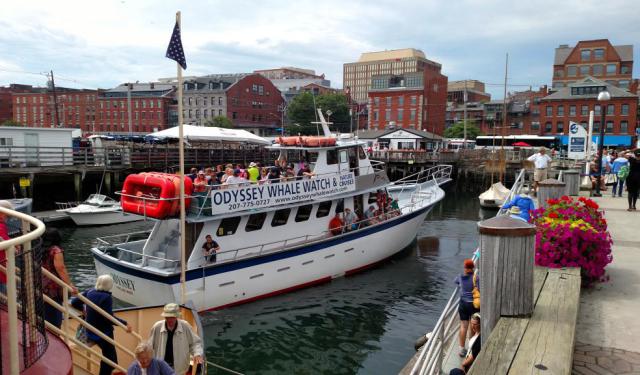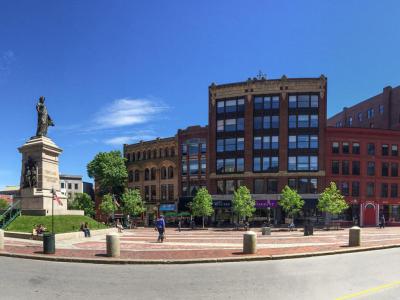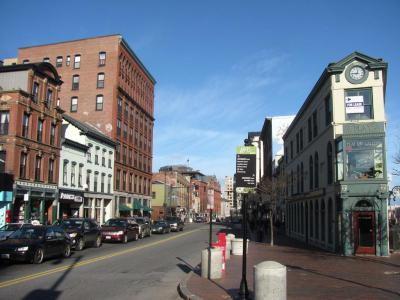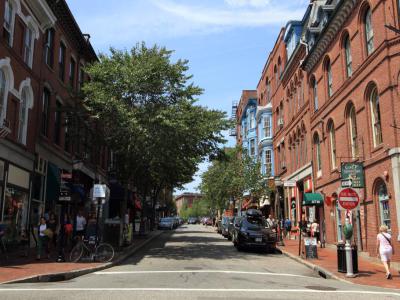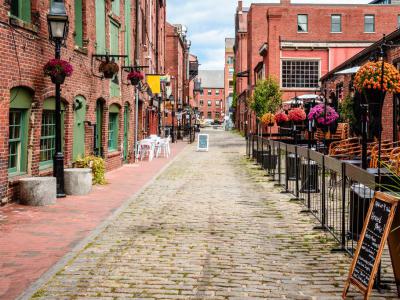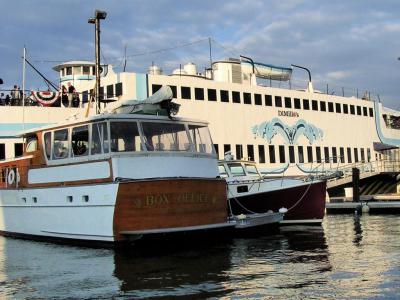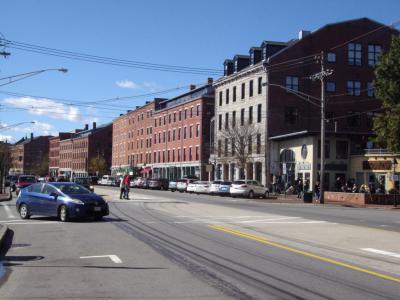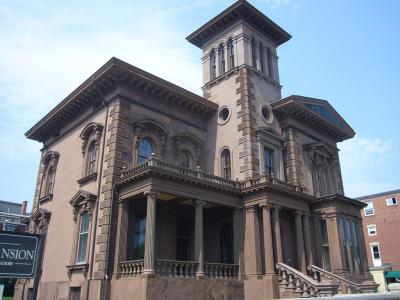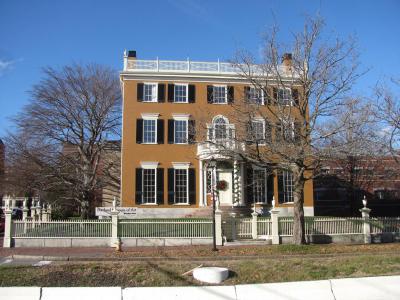Audio Guide: Portland Maine Introduction Walking Tour (Self Guided), Portland
If New York is the city that never sleeps, Portland, Maine, is the city that daydreams with an ocean breeze. Jutting out into Casco Bay, this coastal gem balances big-city energy with the easygoing warmth of a neighborhood you’ve known your whole life.
Long before lobster shacks and artisan coffee shops, the Algonquian people (populous indigenous American group) called this land Machigonne-which means “great neck”-and thrived along its shores. In 1623, English explorer Christopher Levett tried planting a colony here, only to leave behind foundations that vanished into history. By 1786, after fires and skirmishes wiped away the old town of Falmouth, two settlers flipped a coin and christened their rebuilt settlement Portland, borrowing the name from an English isle.
Around the 19th century, and Portland had become New England’s busiest seaport. Ship masts cast long shadows over Wharf Street in the Old Port, where today’s wooden piers cradle fishing boats beside sleek yachts. Salt air mingles with the scent of fresh catch at dawn markets, while Commercial Street hums with nautical antiques, bustling boutiques, and quirky galleries.
At the city’s core, Monument Square anchors downtown with its Soldiers and Sailors Monument standing guard. Congress Street fans out beyond the square, flanked by indie bookstores, espresso labs, and theaters that host everything from Shakespeare to stand-up comedy. A few blocks away, Exchange Street reveals a cozier side: cobblestones underfoot, craft breweries pouring local ales, and hidden eateries serving lobster rolls that taste like Maine distilled.
For waterfront dining with an unforgettable twist, step aboard DiMillo’s Floating Restaurant & Inn, permanently moored at the marina. You’ll toast the sunset as boats drift by and sea gulls quarrel over discarded fries. Back on land, the Victoria Mansion dazzles with frescoed ceilings and glittering chandeliers-an opulent reminder that 19th-century tycoons once called Portland home.
Art aficionados should make a beeline for the Portland Museum of Art, where Winslow Homer’s windswept seascapes share wall space with cutting-edge contemporary installations. It’s proof that in Portland, creative currents run as deep as the ocean itself.
Portland’s charm isn’t just in its history or its harbor-it’s in the unexpected discoveries around every corner. So grab a windbreaker, loosen your belt for chowder, and set out on foot. Pack your sense of wonder and prepare to be surprised.
Long before lobster shacks and artisan coffee shops, the Algonquian people (populous indigenous American group) called this land Machigonne-which means “great neck”-and thrived along its shores. In 1623, English explorer Christopher Levett tried planting a colony here, only to leave behind foundations that vanished into history. By 1786, after fires and skirmishes wiped away the old town of Falmouth, two settlers flipped a coin and christened their rebuilt settlement Portland, borrowing the name from an English isle.
Around the 19th century, and Portland had become New England’s busiest seaport. Ship masts cast long shadows over Wharf Street in the Old Port, where today’s wooden piers cradle fishing boats beside sleek yachts. Salt air mingles with the scent of fresh catch at dawn markets, while Commercial Street hums with nautical antiques, bustling boutiques, and quirky galleries.
At the city’s core, Monument Square anchors downtown with its Soldiers and Sailors Monument standing guard. Congress Street fans out beyond the square, flanked by indie bookstores, espresso labs, and theaters that host everything from Shakespeare to stand-up comedy. A few blocks away, Exchange Street reveals a cozier side: cobblestones underfoot, craft breweries pouring local ales, and hidden eateries serving lobster rolls that taste like Maine distilled.
For waterfront dining with an unforgettable twist, step aboard DiMillo’s Floating Restaurant & Inn, permanently moored at the marina. You’ll toast the sunset as boats drift by and sea gulls quarrel over discarded fries. Back on land, the Victoria Mansion dazzles with frescoed ceilings and glittering chandeliers-an opulent reminder that 19th-century tycoons once called Portland home.
Art aficionados should make a beeline for the Portland Museum of Art, where Winslow Homer’s windswept seascapes share wall space with cutting-edge contemporary installations. It’s proof that in Portland, creative currents run as deep as the ocean itself.
Portland’s charm isn’t just in its history or its harbor-it’s in the unexpected discoveries around every corner. So grab a windbreaker, loosen your belt for chowder, and set out on foot. Pack your sense of wonder and prepare to be surprised.
How it works: Download the app "GPSmyCity: Walks in 1K+ Cities" from Apple App Store or Google Play Store to your mobile phone or tablet. The app turns your mobile device into a personal tour guide and its built-in GPS navigation functions guide you from one tour stop to next. The app works offline, so no data plan is needed when traveling abroad.
Portland Maine Introduction Walking Tour Map
Guide Name: Portland Maine Introduction Walking Tour
Guide Location: USA » Portland (See other walking tours in Portland)
Guide Type: Self-guided Walking Tour (Sightseeing)
# of Attractions: 8
Tour Duration: 2 Hour(s)
Travel Distance: 2.5 Km or 1.6 Miles
Author: DanaOffice
Sight(s) Featured in This Guide:
Guide Location: USA » Portland (See other walking tours in Portland)
Guide Type: Self-guided Walking Tour (Sightseeing)
# of Attractions: 8
Tour Duration: 2 Hour(s)
Travel Distance: 2.5 Km or 1.6 Miles
Author: DanaOffice
Sight(s) Featured in This Guide:
- Monument Square
- Congress Street
- Exchange Street
- Old Port and Wharf Street
- DiMillo Marina
- Commercial Street
- Victoria Mansion
- Portland Museum of Art
1) Monument Square
In the tangle of downtown Portland, Monument Square feels like the city’s living room-where East Bayside meets the Old Port’s salty breeze. Glance around and you’ll spot the Time & Temperature Building blinking updates, the stately Fidelity Trust Building, and the Portland Public Library’s main branch all lining up along Congress Street. Brave souls even call One Monument Square and One City Center their professional homes here.
Center stage, where old City Hall once huddled, stands the Soldiers and Sailors Monument, unveiled in 1891 to honor Maine’s Civil War heroes. Locals affectionately dub her “Our Lady of Victories”- a bronze warrior-woman draped in armor and robes, clutching a neatly furled flag in one hand and a mace and shield in the other. At her feet, trios of soldiers and sailors freeze in bronze display, forever caught between orders and the next battle.
Chisel in hand, sculptor Franklin Simmons breathed life into the figures while New York architect Richard Morris Hunt crafted the monument’s sturdy granite plinth. Portland’s own Francis H. Fassett first landscaped the grounds-though time has since sent those original flowerbeds to the history books. All things considered, Monument Square earned a spot on the National Register of Historic Places in 1998.
Pull up a bench, let the city swirl around you, and tip your hat to the legends immortalized in stone and bronze.
Center stage, where old City Hall once huddled, stands the Soldiers and Sailors Monument, unveiled in 1891 to honor Maine’s Civil War heroes. Locals affectionately dub her “Our Lady of Victories”- a bronze warrior-woman draped in armor and robes, clutching a neatly furled flag in one hand and a mace and shield in the other. At her feet, trios of soldiers and sailors freeze in bronze display, forever caught between orders and the next battle.
Chisel in hand, sculptor Franklin Simmons breathed life into the figures while New York architect Richard Morris Hunt crafted the monument’s sturdy granite plinth. Portland’s own Francis H. Fassett first landscaped the grounds-though time has since sent those original flowerbeds to the history books. All things considered, Monument Square earned a spot on the National Register of Historic Places in 1998.
Pull up a bench, let the city swirl around you, and tip your hat to the legends immortalized in stone and bronze.
2) Congress Street
Congress Street is the city’s main artery, stretching from the city’s western edge all the way to the sunny slopes of the Eastern Promenade. In March 2009, the City Council stamped its seal of approval on much of the inner blocks by declaring them a historic district-one that pulses with galleries, studios, and cafés in the Arts District to the west.
Back in the early 1700s, British settlers clustered around the waterfront at what we now call India Street. Meanwhile, a modest lane named Back Street was laid out inland, lined with the town’s earliest landmarks: a 1740 meetinghouse for the First Parish, and hay scales in what would become Monument Square. By the time the Revolutionary War drums were pounding, Back Street marked the edge of town. Two centuries later, its grown-up name, Congress Street, came into official use in 1823-making it the place where politics, parades, and Portland’s vibrant everyday life collide.
Hop eastward and you’ll discover the Etz Chaim Synagogue, built in 1921 near Munjoy Hill. It’s a rare survivor of Maine’s immigrant-era synagogues and, as of 2011, the state’s only one still in service. From colonial origins to modern-day art walk, Congress Street tells Portland’s story in brick, granite, and a dash of flair-one block at a time.
Back in the early 1700s, British settlers clustered around the waterfront at what we now call India Street. Meanwhile, a modest lane named Back Street was laid out inland, lined with the town’s earliest landmarks: a 1740 meetinghouse for the First Parish, and hay scales in what would become Monument Square. By the time the Revolutionary War drums were pounding, Back Street marked the edge of town. Two centuries later, its grown-up name, Congress Street, came into official use in 1823-making it the place where politics, parades, and Portland’s vibrant everyday life collide.
Hop eastward and you’ll discover the Etz Chaim Synagogue, built in 1921 near Munjoy Hill. It’s a rare survivor of Maine’s immigrant-era synagogues and, as of 2011, the state’s only one still in service. From colonial origins to modern-day art walk, Congress Street tells Portland’s story in brick, granite, and a dash of flair-one block at a time.
3) Exchange Street
In Portland’s Old Port, Exchange Street has morphed from gritty printing press row into the neighborhood’s trendiest runway. By day, you’ll sidestep well-heeled shoppers ducking into sleek fashion boutiques, while local gems-think indie coffee spots (one even doubles as an Internet café)-brew community spirit by the cup. Since 2015, tiny dance slippers have joined the mix at Exchange Street Studio, where ballerinas pirouette above the cobblestones.
A century ago, this street was all about the press: hoisting ink-stained banners day and night. The Press Herald Building, born in 1923 at Congress Street’s corner, grew up in 1948 to house Maine’s paper of record. After a 2015 facelift, its newsprint past gave way to plush pillows and cocktails at the Press Hotel, proving that newspapers can enjoy a revamp.
Believe it or not, by the late ’60s, Exchange Street was flirting with dereliction. But gentrification swept in during the early ’70s, and now the Old Port pulses with life-film festivals, seafood shacks, and a soundtrack of clinking glasses.
Exchange Street has traded printing presses for espresso machines and shopfront windows-but it still knows how to keep the city talking.
A century ago, this street was all about the press: hoisting ink-stained banners day and night. The Press Herald Building, born in 1923 at Congress Street’s corner, grew up in 1948 to house Maine’s paper of record. After a 2015 facelift, its newsprint past gave way to plush pillows and cocktails at the Press Hotel, proving that newspapers can enjoy a revamp.
Believe it or not, by the late ’60s, Exchange Street was flirting with dereliction. But gentrification swept in during the early ’70s, and now the Old Port pulses with life-film festivals, seafood shacks, and a soundtrack of clinking glasses.
Exchange Street has traded printing presses for espresso machines and shopfront windows-but it still knows how to keep the city talking.
4) Old Port and Wharf Street (must see)
Imagine a neighborhood that feels like a living history exhibit-but one where you’re invited to sip craft beer and nibble lobster rolls along the way. That’s the Old Port Exchange, Portland’s beloved old-timer district defined by snaking cobblestones, 19th-century brick facades, and wooden piers where fishing boats still tie up.
Wander down Wharf Street and you’ll see why this strip has its own magnetic pull. Candlelit tables spill onto the cobbles, giving seafood feasts a glow that gold-plated floors could never match. Boutique shops line the street between rustic pubs, while galleries showcase local artists whose work is inspired by the city’s history, textures, and everyday rhythm. By evening, the Old Port hums with energy, as locals and out-of-towners converge on cozy taverns and rooftop lounges.
But there’s more to this historic quarter than nightlife. Post Office Park and Tommy’s Park offer leafy respites if you need to swap your bar stools for a bench. A quick jaunt down to Bell Buoy Park, found beside the Casco Bay Ferry Terminal, will reward you with sea breezes and ferryhorn fanfares. And don’t miss the tail-end of the Eastern Promenade Trail, which funnels right into the Old Port-you can stroll off your morning pastry seamlessly.
What makes the Old Port truly enchanting is its blend of old and new: centuries-old warehouses reborn as sleek restaurants, centuries-old stones that still feel alive under your steps, and a waterfront vibe so authentic you might taste the salt in the air.
Wander down Wharf Street and you’ll see why this strip has its own magnetic pull. Candlelit tables spill onto the cobbles, giving seafood feasts a glow that gold-plated floors could never match. Boutique shops line the street between rustic pubs, while galleries showcase local artists whose work is inspired by the city’s history, textures, and everyday rhythm. By evening, the Old Port hums with energy, as locals and out-of-towners converge on cozy taverns and rooftop lounges.
But there’s more to this historic quarter than nightlife. Post Office Park and Tommy’s Park offer leafy respites if you need to swap your bar stools for a bench. A quick jaunt down to Bell Buoy Park, found beside the Casco Bay Ferry Terminal, will reward you with sea breezes and ferryhorn fanfares. And don’t miss the tail-end of the Eastern Promenade Trail, which funnels right into the Old Port-you can stroll off your morning pastry seamlessly.
What makes the Old Port truly enchanting is its blend of old and new: centuries-old warehouses reborn as sleek restaurants, centuries-old stones that still feel alive under your steps, and a waterfront vibe so authentic you might taste the salt in the air.
5) DiMillo Marina
Welcome to DiMillo Marina, the crown jewel of the local waterfront-where boaters find their haven and visitors get the perfect mix of luxury and laid-back charm. This marina is the gateway to an unforgettable waterfront experience.
Resting on the edge of Portland Harbor, DiMillo Marina boasts spectacular views of Casco Bay, with its islands dotting the horizon. It’s the ideal spot to kick off your Portland adventure, with easy access to all the sights, sounds, and tastes of the city. Think historic charm meets coastal beauty-what’s not to love?
Not only does the marina offer top-notch facilities, but it also caters to boaters big and small, with 125 slips for transient and seasonal docking. Whether you’re cruising in on a sleek yacht or a modest dinghy, every slip comes with Wi-Fi, electricity, and water hookups. And if your boat’s been a little too much at sea, DiMillo’s full-service boatyard has you covered-from engine fixes to hull repairs, and everything in between.
Explore Portland’s eclectic shops, dine in charming restaurants, or wander the cobblestone streets of the Old Port. It’s all just a short stroll away, making DiMillo Marina the ultimate spot for both boating fanatics and land lovers alike.
Resting on the edge of Portland Harbor, DiMillo Marina boasts spectacular views of Casco Bay, with its islands dotting the horizon. It’s the ideal spot to kick off your Portland adventure, with easy access to all the sights, sounds, and tastes of the city. Think historic charm meets coastal beauty-what’s not to love?
Not only does the marina offer top-notch facilities, but it also caters to boaters big and small, with 125 slips for transient and seasonal docking. Whether you’re cruising in on a sleek yacht or a modest dinghy, every slip comes with Wi-Fi, electricity, and water hookups. And if your boat’s been a little too much at sea, DiMillo’s full-service boatyard has you covered-from engine fixes to hull repairs, and everything in between.
Explore Portland’s eclectic shops, dine in charming restaurants, or wander the cobblestone streets of the Old Port. It’s all just a short stroll away, making DiMillo Marina the ultimate spot for both boating fanatics and land lovers alike.
6) Commercial Street
Commercial Street-Portland’s heart and soul, where history meets hustle, and the waterfront scene is always on display. This lively street, named one of the ten best in the U.S. by the American Planning Association in 2008, is where the city’s past and present collide, making it a must-see for locals and tourists alike.
Let’s rewind to the 1850s, when Commercial Street was born from the waters of Casco Bay, courtesy of a little land reclamation project. The railroad and warehousing industries were booming, and the old piers were transformed into this bustling thoroughfare that has since driven the city’s economy and access to the working waterfront.
Jumping to today, and you'll find landmarks like the Maine State Pier, a bustling deepwater hub by day and an outdoor concert venue by night. At the far end of the street, you’ll find the charming Widgery Wharf and Union Wharf, which have been standing since the late 1700s, keeping Portland’s maritime heritage alive.
With a perfect blend of old-school charm and modern energy, Commercial Street is the place to be. One moment you’re passing lobster traps, the next it’s latte art. Either way, the tide’s always coming in with another story.
Let’s rewind to the 1850s, when Commercial Street was born from the waters of Casco Bay, courtesy of a little land reclamation project. The railroad and warehousing industries were booming, and the old piers were transformed into this bustling thoroughfare that has since driven the city’s economy and access to the working waterfront.
Jumping to today, and you'll find landmarks like the Maine State Pier, a bustling deepwater hub by day and an outdoor concert venue by night. At the far end of the street, you’ll find the charming Widgery Wharf and Union Wharf, which have been standing since the late 1700s, keeping Portland’s maritime heritage alive.
With a perfect blend of old-school charm and modern energy, Commercial Street is the place to be. One moment you’re passing lobster traps, the next it’s latte art. Either way, the tide’s always coming in with another story.
7) Victoria Mansion (must see)
Victoria Mansion is the city’s very own architectural gem-a dazzling example of American residential design from the mid-19th century. Built in 1860 as a summer escape for Ruggles Sylvester Morse, a hotel magnate who struck it rich in New York, Boston, and New Orleans, this mansion oozes grandeur and history.
Designed by Henry Austin, this brownstone Italianate beauty got that cool, asymmetrical flair with a four-story tower, overhanging eaves, and verandas that practically beg you to relax with a cool drink. Inside, the mansion’s charm continues with intricate frescoes and three-dimensional wall art, all thanks to the talented Giuseppe Guidicini.
The mansion had a cozy family feel until 1928, when the last member of the Libby family left. After the economic hardships of the Great Depression and the disastrous 1938 Portland flood, the house faced potential demolition (seriously, a gas station was on the cards). But, thankfully, the mansion was rescued in 1941, and lovingly restored to honor its royal inspiration-Queen Victoria.
Now listed on the National Historic Register, Victoria Mansion is a museum that transports you straight back to the opulent 19th century. It's a true testament to Portland’s rich history and an absolute must-see for anyone who enjoys a bit of grandeur, with a side of history-and maybe royalty sprinkled in.
Designed by Henry Austin, this brownstone Italianate beauty got that cool, asymmetrical flair with a four-story tower, overhanging eaves, and verandas that practically beg you to relax with a cool drink. Inside, the mansion’s charm continues with intricate frescoes and three-dimensional wall art, all thanks to the talented Giuseppe Guidicini.
The mansion had a cozy family feel until 1928, when the last member of the Libby family left. After the economic hardships of the Great Depression and the disastrous 1938 Portland flood, the house faced potential demolition (seriously, a gas station was on the cards). But, thankfully, the mansion was rescued in 1941, and lovingly restored to honor its royal inspiration-Queen Victoria.
Now listed on the National Historic Register, Victoria Mansion is a museum that transports you straight back to the opulent 19th century. It's a true testament to Portland’s rich history and an absolute must-see for anyone who enjoys a bit of grandeur, with a side of history-and maybe royalty sprinkled in.
8) Portland Museum of Art (must see)
The Portland Museum of Art-PMA if you’re in a hurry-is Maine’s proud answer to the Louvre… just with more flannel and fewer baguettes. Founded way back in 1882 as the Portland Society of Art, it holds the title of the state’s oldest and largest public art museum. Basically, it’s been curating beauty since before electricity was cool.
Things really took off in 1908, when local tastemaker Margaret Jane Mussey Sweat donated her stately mansion-plus enough cash to build a memorial gallery for her husband, former U.S. Rep. Lorenzo De Medici Sweat (yes, that’s really his name). The result was the L.D.M. Sweat Memorial Galleries, designed by Maine’s own architectural ace, John Calvin Stevens, and opened to the public in 1911. Classy from the start.
Today, PMA flexes a collection of more than 22,000 works, covering everything from 18th-century depictions to forward-thinking installations that make you question your life choices (in a good way). Stroll through the galleries and bump elbows with Maine legends like Winslow Homer, Andrew Wyeth or get lost in brushstrokes courtesy of Marsden Hartley and John Marin.
Craving something European? The museum delivers. Thanks to heavy-hitting collections like those of Joan Whitney Payson, you’ll spot familiar names like Monet, Degas, Picasso, and Rodin. Not to be outdone, the Elizabeth B. Noyce Collection adds a homegrown twist, spotlighting George Bellows, Jamie Wyeth, and others who helped define American art.
And this isn’t just a “look, don’t touch” museum. PMA rolls out temporary exhibits, artist talks, film screenings, and school programs that make art feel less like homework and more like something you’d text your friends about. The Portland Museum of Art can definitely impress you, just make sure you don't get lost in the sea of colors.
Things really took off in 1908, when local tastemaker Margaret Jane Mussey Sweat donated her stately mansion-plus enough cash to build a memorial gallery for her husband, former U.S. Rep. Lorenzo De Medici Sweat (yes, that’s really his name). The result was the L.D.M. Sweat Memorial Galleries, designed by Maine’s own architectural ace, John Calvin Stevens, and opened to the public in 1911. Classy from the start.
Today, PMA flexes a collection of more than 22,000 works, covering everything from 18th-century depictions to forward-thinking installations that make you question your life choices (in a good way). Stroll through the galleries and bump elbows with Maine legends like Winslow Homer, Andrew Wyeth or get lost in brushstrokes courtesy of Marsden Hartley and John Marin.
Craving something European? The museum delivers. Thanks to heavy-hitting collections like those of Joan Whitney Payson, you’ll spot familiar names like Monet, Degas, Picasso, and Rodin. Not to be outdone, the Elizabeth B. Noyce Collection adds a homegrown twist, spotlighting George Bellows, Jamie Wyeth, and others who helped define American art.
And this isn’t just a “look, don’t touch” museum. PMA rolls out temporary exhibits, artist talks, film screenings, and school programs that make art feel less like homework and more like something you’d text your friends about. The Portland Museum of Art can definitely impress you, just make sure you don't get lost in the sea of colors.
Walking Tours in Portland, Maine
Create Your Own Walk in Portland
Creating your own self-guided walk in Portland is easy and fun. Choose the city attractions that you want to see and a walk route map will be created just for you. You can even set your hotel as the start point of the walk.
Historical Buildings Walking Tour
Portland, Maine may be small, but it packs centuries of history into its streets. Think of it as a living scrapbook-some pages sing in stone, others whisper in brick, and all of them survived the city’s Great Fire of 1866, which could’ve erased it all. Instead, Portland rebuilt in style, and today you can wander its historic core spotting everything from colonial leftovers to Victorian... view more
Tour Duration: 2 Hour(s)
Travel Distance: 3.1 Km or 1.9 Miles
Tour Duration: 2 Hour(s)
Travel Distance: 3.1 Km or 1.9 Miles
The Most Popular Cities
/ view all
